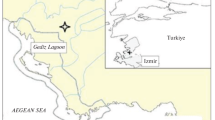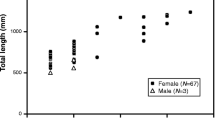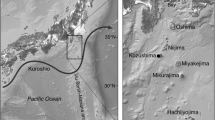Abstract
One of the major problems in artificial eel reproduction is identification of broodstock with high performance reproductive characteristics. The aim of this study was to study population characteristics and the reproductive potential of eels (Anguilla anguilla) located in Valle Campo valley (Comacchio, Italy). A total of 200 eels/period (spring–summer and autumn–winter) were measured to obtain an external indicator of their maturation state. Morphometric parameters were used to calculate condition factor (K), eye index (EI) and pectoral fin length index (PFLI). Silver index analyses showed the lack of silver males and of fully mature females. Most represented females were yellow females at stage II. Silver females represented 27.9% of the population. Seasonal analysis shows how temperature reduction favoured the presence of silver females versus yellow females. Statistical analysis of EI, cranial (CI), PFLI and gonadosomatic (GSI) indexes showed that significant differences were found for EI, CI, PFLI and GSI between yellow and silver eels. No significant difference was found between stage III and IV silver eels, while a significant difference for EI was found between stage I and II yellow eels and for IC at stage II with respect to all other stages. The present study defined how Valle Campo could present environmental and trophic conditions which could favour precocious development of a population of silver females with a noticeable reproductive potential, to be used in open sea release or in artificial reproduction programmes. On the contrary, the valley seems to present unfavourable conditions for both development and sexual maturation of male eels.




Similar content being viewed by others
References
Aliniya M, Khara H, Noveiri SB, Dadras H (2013) Influence of age of common carp (Cyprinus carpio) broodstock on reproductive traits and fertilization. Turkish Journal of Fisheries Aquatic Sciences - Research Across Boundaries 13
Aschonitis V, Castaldelli G, Lanzoni M, Rossi R, Kennedy C, Fano EA (2017) Long-term records (1781–2013) of European eel (Anguilla anguilla L.) production in the Comacchio lagoon (Italy): evaluation of local and global factors as causes of the population collapse. Aquatic Conservation: Marine Freshwater Ecosystems 27:502–520
Beentjes M, Jellyman D, Kim SW (2006) Changing population structure of eels (Anguilla dieffenbachii and A. australis) from southern New Zealand. Ecol Freshw Fish 15:428–440
Bevacqua D, Melià P, Crivelli AJ, De Leo GA, Gatto M (2005) Un modello di accrescimento con differenziazione sessuale per l’anguilla europea (Anguilla anguilla). In: XV Congresso XV Congresso Nazionale della Società Italiana di Ecologia. pp 1–9
Boëtius I, Boétius J (1985) Lipid and protein content in Anguilla anguilla during growth and starvation Dana
Burgerhout E et al (2011) First artificial hybrid of the eel species Anguilla australis and Anguilla anguilla. BMC Dev Biol 11:16
Carrieri A, Cavallini G, Plazzi M, Rossi R (1992) Struttura della popolazione di anguille gialle ed argentine (Anguilla anguilla L.) nelle Valli di Comacchio (Biennio 1989-90) Annali dell'Univ di Ferrara NS Sez Biologia e medicina 2
Casselman JM (2003) Dynamics of resources of the American eel, Anguilla rostrata: declining abundance in the 1990s. Eel biology. Springer, In, pp 255–274
Castaldelli G, Aschonitis V, Lanzoni M, Gelli F, Rossi R, Fano E (2014) An update of the length–weight and length–age relationships of the European eel (Anguilla anguilla, Linnaeus 1758) in the Comacchio lagoon, northeast Adriatic Sea, Italy. J Appl Ichthyol 30:558–559
Chu Y-W, Han Y-S, Wang C-H, You C-F, Tzeng W-N (2006) The sex-ratio reversal of the Japanese eel Anguilla japonica in the Kaoping River of Taiwan: the effect of cultured eels and its implication. Aquaculture 261:1230–1238
Ciccotti E (1997) Italy. In: Moriarty C, Dekker W (eds) Management of the European eel, vol 15. Irish Fisheries Bulletin, pp 61–65
Colombo G, Grandi G (1996) Histological study of the development and sex differentiation of the gonad in the European eel. J Fish Biol 48:493–512
Couillard CM, Verreault G, Dumont P, Stanley D, Threader RW (2014) Assessment of fat reserves adequacy in the first migrant silver American eels of a large-scale stocking experiment. North American journal of fisheries management 34:802–813
De Francesco M et al (2007) Effect of high-level fish meal replacement by plant proteins in gilthead sea bream (Sparus aurata) on growth and body/fillet quality traits. Aquac Nutr 13:361–372
De Leo G, Gatto M (1995) A size and age-structured model of the European eel (Anguilla anguilla L) Canadian Journal of Fisheries and Aquatic Sci Aquatic Sci 52:1351–1367
Dekker W (2003) Did lack of spawners cause the collapse of the European eel, Anguilla anguilla? Fish Manag Ecol 10:365–376
Di Biase A, Bastone G, Casalini A, Parmeggiani A, Costantini G, Mordenti O (2012) Study of the morpho-physiological characteristics of two Anguilla anguilla populations selected for artificial reproduction. In: Word Aquaculture Society, Conference: Global aquaculture: securing our future-AQUA, pp 1–5
Di Biase A, Casalini A, Emmanuele P, Mandelli M, Lokman PM, Mordenti O (2016) Controlled reproduction in Anguilla anguilla (L.): comparison between spontaneous spawning and stripping-insemination approaches. Aquac Res 47:3052–3060
Di Biase A, Lokman PM, Govoni N, Casalini A, Emmanuele P, Parmeggiani A, Mordenti O (2017) Co-treatment with androgens during artificial induction of maturation in female eel, Anguilla anguilla: effects on egg production and early development. Aquaculture 479:508–515
Durif C, Dufour S, Elie P (2005) The silvering process of Anguilla anguilla: a new classification from the yellow resident to the silver migrating stage. J Fish Biol 66:1025–1043
Durif CM, Dufour S, Elie P (2006) Impact of silvering stage, age, body size and condition on reproductive potential of the European eel. Mar Ecol Prog Ser 327:171–181
Durif CM, van Ginneken V, Dufour S, Müller T, Elie P (2009) Seasonal evolution and individual differences in silvering eels from different locations. In: Spawning migration of the European eel. Springer, Berlin, pp 13–38
Edeline E, Elie P (2004) Is salinity choice related to growth in juvenile eel Anguilla anguilla Cybium 28:77–82
EELREP (2006) Estimation of the reproduction capacity of European eel. Final Report, EU Project, EELREP
Gatto M, Rossi R (1979) A method for estimating mortalities and abundances of the Valli di Comacchio eels. Memorie dell’Istituto Italiano di Idrobiologia Supplement 37:107–114
Geffroy B et al (2016) Sexually dimorphic gene expressions in eels: useful markers for early sex assessment in a conservation context. Scientific reports 6:34041
Han Y-S, Tzeng W-N (2006) Use of the sex ratio as a means of resource assessment for the Japanese eel Anguilla japonica: a case study in the Kaoping River, Taiwan. Zoological studies 45:255–263
Helfman GS, Facey DE, Hales LS Jr, Bozeman EL Jr (1987) Reproductive ecology of the American eel. In: American Fisheries Society Symposium, pp 42–56
Huertas M, Scott AP, Hubbard PC, Canário AV, Cerdà J (2006) Sexually mature European eels (Anguilla anguilla L.) stimulate gonadal development of neighbouring males: possible involvement of chemical communication. General Comparative Endocrinol 147:304–313
Ide C et al (2011) Bimodality in head shape in European eel. J Zool 285:230–238
Krueger WH, Oliveira K (1999) Evidence for environmental sex determination in the American eel, Anguilla rostrata. Environ Biol Fishes 55:381–389
Melià P, Bevacqua D, Crivelli A, Panfili J, De Leo G, Gatto M (2006) Sex differentiation of the European eel in brackish and freshwater environments: a comparative analysis. J Fish Biol 69:1228–1235
Modugno S, Di Biase A, Mordenti O, Rinaldi A (2010) A scientific challenge for the future: use of silvering index to select, manage and maintain possible spawners for a laboratory hormonal induction tests for eels. In: Aquaculture Europe 10, Porto, Portugal, October 5–8 2010. European Aquaculture Society, pp 837–838
Mordenti M, Di Biase A, Sirri R, Modugno S, Tasselli A (2012) Induction of sexual maturation in wild female European eels (Anguilla anguilla) in Darkness and Light: 1–9
Mordenti O, Di Biase A, Bastone G, Sirri R, Zaccaroni A, Parmeggiani A (2013) Controlled reproduction in the wild European eel (Anguilla anguilla): two populations compared. Aquaculture Int 21:1045–1063
Mordenti O, Di Biase A, Casalini A, Emmanuele P, Melotti P, Roncarati A (2016) Growth performances and natural diet of European eel (Anguilla anguilla L.) reared in muddy and sandy ponds. Aquatic Living Resources 29:105
Mordenti O, Casalini A, Parmeggiani A, Emmanuele P, Zaccaroni A (2019) Captive breeding of the European eel: Italian review eels biology. In: Don A, Coulson P (eds) Monitoring, management, culture and exploitation: proceedings of the First International Eel Science Symposium. 5M Publishing, Charlbury, UK, pp 317–339
Morrison WE, Secor DHJ (2003) Demographic attributes of yellow-phase American eels (Anguilla rostrata) in the Hudson River estuary Canadian. J Fish Aquat Sci 60:1487–1501
Okamura A et al (2009) Growth and survival of eel leptocephali (Anguilla japonica) in low-salinity water. Aquaculture 296:367–372
Okamura A, Horie N, Mikawa N, Yamada Y, Tsukamoto K (2014) Recent advances in artificial production of glass eels for conservation of anguillid eel populations. Ecology of Freshwater Fish 23:95–110
Oliveira K, Hable W (2010) Artificial maturation, fertilization, and early development of the American eel (Anguilla rostrata). Can J Zool 88:1121–1128
Palstra A, van den Thillart G (2009) Artificial maturation and reproduction of the European eel. In: Spawning migration of the European eel. Springer, Berlin, pp 309–331
Parmeggiani A et al (2015) Effect of photoperiod on endocrine profiles and vitellogenin expression in European eels Anguilla anguilla during artificially induced ovarian development. Theriogenology 83:478–484
Pedersen BH (2004) Fertilisation of eggs, rate of embryonic development and hatching following induced maturation of the European eel Anguilla anguilla. Aquaculture 237:461–473
Pedersen KH, Pedersen SN, Pedersen KL, Korsgaard B, Bjerregaard P (2003) Estrogenic effect of dietary 4-tert-octylphenol in rainbow trout (Oncorhynchus mykiss). Aquat Toxicol 62:295–303
Regulation C (2007) No. 1100/2007 of 18 September 2007 establishing measures for the recovery of the stock of European eel. Official Journal of the European Union L 248:22.29
Roncarati A, Melotti P, Mordenti O, Gennari L (1997) Influence of stocking density of European eel (Anguilla anguilla, L.) elvers on sex differentiation and zootechnical performances. J Appl Ichthyol 13:131–136
Rossi R (1979) An estimate of the production of the eel population (Anguilla anguilla L.) in the Valli di Comacchio (Po Delta) in the period 1974-76. Bollettino di Zoologia 46:217–223
Rossi R, Cataudella S (1998) La produzione ittica nelle Valli di Comacchio Laguna 5:67–76
Rossi R, Colombo G (1976) Sex ratio, age and growth of silver eels in two brackish lagoons in the northern Adriatic (Valli di Comacchio and Valle Nuova). Archivio di Oceanografia e Limnologia 18:227–310
Rousseau K, Aroua S, Schmitz M, Elie P, Dufour S (2009) Silvering: metamorphosis or puberty? In: Spawning migration of the European eel. Springer, pp 39–63
Sorteni C et al (2014) Enteric neuroplasticity in seawater-adapted European eel (Anguilla anguilla). J Anat 224:180–191
Stacey JA, Pratt TC, Verreault G, Fox MG (2015) A caution for conservation stocking as an approach for recovering Atlantic eels Aquatic Conservation: Marine Freshwater Ecosystems 25:569–580
Stearns SC, Koella JC (1986) The evolution of phenotypic plasticity in life-history traits: predictions of reaction norms for age and size at maturity Evolution & Development 40:893–913
Svedäng H, Wickström H (1997) Low fat contents in female silver eels: indications of insufficient energetic stores for migration and gonadal development. J Fish Biol 50:475–486
Tanaka H, Kagawa H, Ohta H (2001) Production of leptocephali of Japanese eel (Anguilla japonica) in captivity. Aquaculture 201:51–60
Tesch F (2003) The eel. Blackwell Science, Oxford (UK)
Tzeng W, Lin H, Wang C, Xu S (2000) Differences in size and growth rates of male and female migrating Japanese eels in Pearl River, China. J Fish Biol 57:1245–1253
Tzeng W-N, Han Y-S, He J-T The sex ratios and growth strategies of wild and captive Japanese eels Anguilla japonica. In: Developments in understanding fish growth (B. Small and D. MacKinlay eds.). International Congress on the Biology of Fish. Univ. British Columbia, 2002. pp 25–42
van den Thillart G, Dufour S (2009) How to estimate the reproductive success of European silver eels. In: Spawning migration of the European eel. Springer, Berlin, pp 3–9
van Ginneken VJ, Maes GE (2005) The European eel (Anguilla anguilla, Linnaeus), its lifecycle, evolution and reproduction: a literature review. Rev Fish Biol Fish 15:367–398
Vøllestad LA (1992) Geographic variation in age and length at metamorphosis of maturing European eel: environmental effects and phenotypic plasticity. J Anim Ecol:41–48
Vøllestad LA, Jonsson B (1986) Life-history characteristics of the European eel Anguilla anguilla in the Imsa River, Norway. Trans Am Fish Soc 115:864–871
Acknowledgements
The authors would like to thank Mr. Giuseppino Nordi and his son Enrico for making the valley they are managing available to us, giving us all equipment necessary for fishing eels and for donating us the eels used in this study.
Author information
Authors and Affiliations
Corresponding author
Ethics declarations
Conflict of interest
The authors declare that they have no conflict of interest.
Additional information
Publisher’s note
Springer Nature remains neutral with regard to jurisdictional claims in published maps and institutional affiliations.
Highlights
• The data underlined an imbalance of sex ratio of Valle Campo eel population towards females and the lack of silver males.
• Biometrics characteristics of silver females present a significant higher lipidic content and a fast maturation rate with respect to other eel populations from the Northern Adriatic basin.
• Valle Campo could present environmental and trophic conditions which could favour precocious development of a population of silver females.
• The valley seems to present unfavourable conditions for both development and sexual maturation of male eels.
Rights and permissions
About this article
Cite this article
Emmanuele, P., Casalini, A., Pisati, D. et al. Artificial reproduction of Anguilla anguilla: evaluation of biometrics characteristics of a population from Valle Campo Lagoon, Comacchio (Italy). Aquacult Int 28, 777–790 (2020). https://doi.org/10.1007/s10499-019-00494-z
Received:
Accepted:
Published:
Issue Date:
DOI: https://doi.org/10.1007/s10499-019-00494-z




